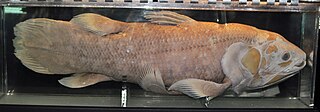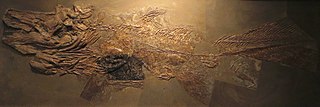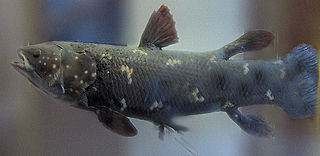
The coelacanths are fish belonging to the order Actinistia that includes two extant species in the genus Latimeria: the West Indian Ocean coelacanth, primarily found near the Comoro Islands off the east coast of Africa, and the Indonesian coelacanth. The name "coelacanth" originates from the Permian genus Coelacanthus, which was the first scientifically named coelacanth.

Latimeria is a rare genus of fish which contains the only living species of coelacanth. It includes two extant species: the West Indian Ocean coelacanth and the Indonesian coelacanth. They follow the oldest known living lineage of Sarcopterygii, which means they are more closely related to lungfish and tetrapods than to the common ray-finned fishes and cartilaginous fishes.

Macropoma is an extinct genus of coelacanth in the class Sarcopterygii. These fish have been extinct for over 70 million years and are most closely related to the modern coelacanth Latimeria.

The West Indian Ocean coelacanth is a crossopterygian, one of two extant species of coelacanth, a rare order of vertebrates more closely related to lungfish and tetrapods than to the common ray-finned fishes. The other extant species is the Indonesian coelacanth.

Latimeriidae is the only extant family of coelacanths, an ancient lineage of lobe-finned fish. It contains two extant species in the genus Latimeria, found in deep waters off the coasts of southern Africa and east-central Indonesia. In addition, several fossil genera are known from the Mesozoic of Europe, the Middle East, and the southeastern United States, dating back to the Triassic.
Paleontology or palaeontology is the study of prehistoric life forms on Earth through the examination of plant and animal fossils. This includes the study of body fossils, tracks (ichnites), burrows, cast-off parts, fossilised feces (coprolites), palynomorphs and chemical residues. Because humans have encountered fossils for millennia, paleontology has a long history both before and after becoming formalized as a science. This article records significant discoveries and events related to paleontology that occurred or were published in the year 1994.

Axelrodichthys is an extinct genus of mawsoniid coelacanth from the Cretaceous of Africa, North and South America, and Europe. Several species are known, the remains of which were discovered in the Lower Cretaceous (Aptian-Albian) of Brazil, North Africa, and possibly Mexico, as well as in the Upper Cretaceous of Morocco (Cenomanian), Madagascar and France. The Axelrodichthys of the Lower Cretaceous frequented both brackish and coastal marine waters while the most recent species lived exclusively in fresh waters. The French specimens are the last known fresh water coelacanths. Most of the species of this genus reached 1 metre to 2 metres in length. Axelrodichthys was named in 1986 by John G. Maisey in honor of the American ichthyologist Herbert R. Axelrod.
Powichthys is a genus of prehistoric lobe-finned fish which lived during the Devonian period. This fish it was small in size, about 30 cm. Prior to the discovery of P. spitsbergensis in 2004, the genus was known from a single type species, P. thorsteinssoni.

Libys is a genus of coelacanth lobe-finned fish in the family of Latimeridae. Species of Libys lived during the Upper Jurassic period.

Mawsonia is an extinct genus of prehistoric coelacanth fish. It is the amongst the largest of all coelacanths, with one quadrate specimen possibly belonging to an individual measuring 5.3 metres in length. It lived in freshwater and brackish environments from the latest Jurassic to the mid-Cretaceous of South America, eastern North America, and Africa. Mawsonia was first described by British paleontologist Arthur Smith Woodward in 1907.

Piveteauia is an extinct genus of prehistoric coelacanth fish which lived during the Lower Triassic period. The type specimen was discovered in the Middle Sakamena Group in northwestern Madagascar by French paleoichthyologist Jean-Pierre Lehman.
Indocoelacanthus robustus is a fossil sarcopterygian. The holotype specimen was found in Lower Jurassic-aged riverine sediment of the Kota formation, in the Pranhita-Godavari valley at Boraigudem limestone ridge, about 30 kilometers southeast of Sironcha, India. The holotype is preserved in the museum of the Indian Statistical Institute.
Hainbergia is an extinct genus of prehistoric sarcopterygian or lobe-finned fish.

Ptychoceratodus is an extinct genus of lungfish living from Early Triassic to Middle Jurassic. It was established by Otto Jaekel for one species, transferred from Ceratodus genus. Type species is P. serratus from the Middle Triassic of Switzerland and Germany. Ptychoceratodus had two pairs of massive dental plates, bearing 4-6 acute ridges. Its skull roof was composed from massive, plate-like bones. In the central part of skull roof was localized an unossified fenestra. Most of the Ptychoceratodus findings are isolated dental plates, some associated with jaws. Other parts of skull or postcranial skeleton are relatively rarely found as fossils. The anatomy of skull is the best recognized in P. serratus, whereas less complete cranial material is available also for P. concinuus, P. phillipsi, and P. rectangulus. Although Ptychoceratodus is known exclusively from the Triassic and Jurassic, there were also Cretaceous specimens referred to this genus. However, they are more often regarded as representants of Metaceratodus. Ptychoceratodus is the only member of the family Ptychoceratodontidae. The first named species is P. phillipsi by Louis Agassiz in 1837 as a species of Ceratodus and later moved to Ptychoceratodus genus. Occurrences of Ptychoceratodus come mainly from Europe. However, occurrences from other continents suggest it was dispersed globally during the Triassic. After 2010, the new fossil material behind the Europe was reported from South America, India, and Greenland

Trachymetopon is an extinct genus of prehistoric coelacanth from the Jurassic of Europe. Fossils have been found in the Early Jurassic Posidonia Shale of Germany the Middle Jurassic Marnes de Dives of France, and probably the Late Jurassic Kimmeridge Clay of England. Only one species has been named, Trachymetopon liassicum, described by Henning in 1951 from an almost complete specimen found in the Lower Toarcian of Ohmden in Baden-Württemberg. Another specimen is known from the same site, and two older specimens come from the Sinemurian of Holzmaden. The holotype of this species is 1.6 metres in length. A giant specimen of an undetermined species of Trachymetopon found at the Middle Jurassic Falaises des Vaches Noires of Normandy. This specimen, composed of a 53 cm long palatoquadrate, belongs to an individual 4 metres (13 ft) in length. A basisphenoid found in a museum in Switzerland that likely originates from the same locaity probably belonged to an individual around 5 metres long, making Trachymetopon the largest of all coelacanths alongside Mawsonia. A study published in 2015 revealed that this coelacanth belongs to the Mawsoniidae. Trachymetopon is one of the few known mawsoniids to have been exclusively marine, while most of the other members of the group have lived in fresh and brackish waters.

Megalocoelacanthus dobiei is an extinct species of giant latimeriid coelacanth lobe-finned fish which lived during the Lower Campanian epoch until possibly the early Maastrichtian in the Late Cretaceous period in Appalachia, the Western Interior Seaway and Mississippi Embayment. Its disarticulated remains have been recovered from the Eutaw Formation, Mooreville Chalk Formation, and Blufftown Formation of Alabama, Mississippi, and Georgia, and also from the Niobrara Formation of Kansas. Although no complete skeleton is known, careful examination of skeletal elements demonstrate it is closely related to the Jurassic-aged coelacanthid Libys. The species is named for herpetologist James L. Dobie. It has been estimated to have been 3.5—4.5 meters in length.

Latimerioidei is a suborder of coelacanths that contains both extant species of coelacanth in the genus Latimeria. It is defined as "the least inclusive clade containing Latimeria chalumnae and Mawsonia gigas".
Parnaibaia is a genus of coelacanth fish which lived during the Late Jurassic period. Fossils of Parnaibaia have been found in the Pastos Bons Formation in Maranhão, Brazil. Parnaibaia was described for the first time by palaeontologist Yoshitaka Yabumoto in 2008.
This list of fossil fish research presented in 2021 is a list of new taxa of jawless vertebrates, placoderms, acanthodians, fossil cartilaginous fishes, bony fishes, and other fishes that were described during the year, as well as other significant discoveries and events related to paleoichthyology that occurred in 2021.
















